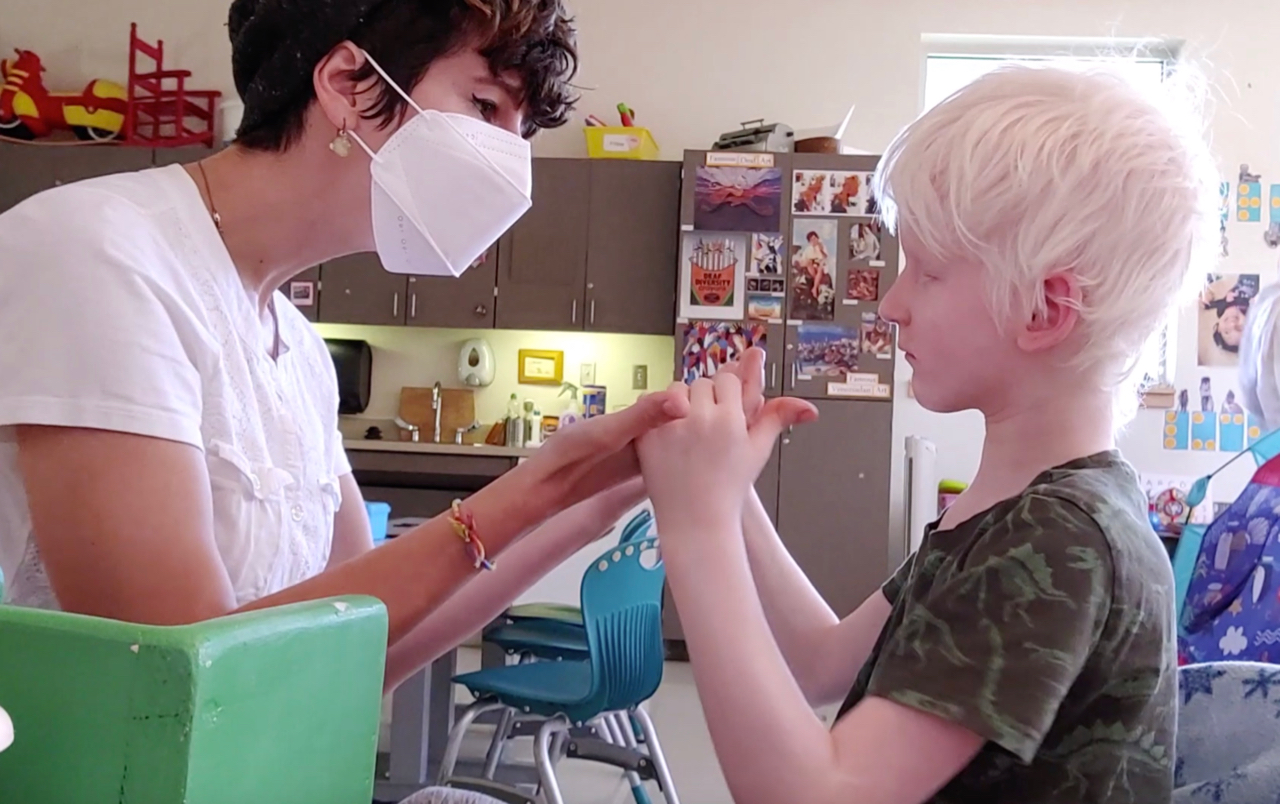Lesson 1 - An Introduction to Deafblindness
Children who are deafblind have combined hearing and vision loss that requires thoughtful and unique educational strategies to ensure they can reach their full potential. This lesson provides a foundational understanding of what deafblindness is and the diversity of children in the population who are deafblind today. It describes how deafblindness impacts teaching as well as the different ways children who are deafblind learn about the world around them. You’ll also understand the importance of identifying deafblindness as early as possible in a child’s life.
For more information, visit the National Center on Deaf-Blindness at nationaldb.org.

Learning Objectives
Lesson 1 has 3 learning objectives. After completing the lesson, participants should be able to
- Define deafblindness and the diversity of the deafblind population
- Demonstrate an understanding that children who are deafblind face significant challenges to learning and need support to access information
- Describe why it is important to identify deafblindness as early as possible
In Part 1, you will learn about deafblindness, the wide diversity of individuals who make up the population of children who are deafblind, the type and level of sensory loss, and whether there are additional medical disabilities. You will also see that despite these differences, children who are deafblind share similar needs, like help to understand their world, communicate, and build social relationships.
Activities
Option 1
The National Center on Deaf-Blindness annually produces the National Deaf-Blind Child Count report, which includes the number of deafblind children nationally and by state, their etiologies, and other important demographic information.
View the latest report. Explore the sections on “Documented Hearing and Vision Loss” and “Additional Disabilities” to learn about characteristics of children in your state.
Option 2
Visit two or three of the following organizations’ websites, which serve children with syndromes associated with deafblindness and their families. Write one to two paragraphs that compare the etiologies and effects of the syndromes.
- CHARGE Syndrome Foundation
- Usher Syndrome Coalition
- National Down Syndrome Society
- Stickler Involved People (Stickler Syndrome)
- Dandy-Walker Alliance
- FACES: The National Craniofacial Association (Goldenhar Syndrome)
- Global Foundation for Peroxisomal Disorders
- CdLS Foundation (Cornelia de Lange Syndrome)
Option 3
Take some time to review the information on the National Center on Deaf-Blindness Causes of Deaf-Blindness page. What did you learn about etiologies that adds to what you learned in this lesson?
Option 4: Collaborative Activity/Discussion
Working with a partner or team, select a typical age-appropriate activity or skill that you want to teach a child how to do (e.g., brush teeth, count to 10, pour a glass of liquid, identify their state on a map). Imagine that you’ll teach this activity or skill to a child you know who is deafblind or to Paul or Liam, who you met in this lesson. Brainstorm a list of what you might need to do differently if the child has vision and hearing loss. Then, discuss ways you might overcome these challenges.
Option 5: Collaborative Activity/Discussion
Now that you’ve completed this lesson, what concerns do you have about working with a child who is deafblind? What information most intrigues you or surprises you? What resonates with your teaching style? Discuss these thoughts with your partner.
Part 2 - The Impact of Deafblindness on Learning
Part 2 focuses on how deafblindness impacts a child’s learning. You’ll see how children don’t have access to incidental information and typically have gaps in their concept development. And you’ll learn how important it is to build a solid foundation of trust with a child who is deafblind.
Activities
Option 1
What is something you have encountered in the classroom (or the home) where a hearing-sighted child had access to information incidentally? How would it be different for Liam, Ava, or Paul to learn this information (you met them in Lesson 1, Part 1)? Write a short essay that describes the differences.
Option 2: Collaborative Activity/Discussion
Discuss the following with your partner or teammates:
- Describe three things not mentioned in this lesson that a hearing-sighted infant or toddler learns incidentally.
- Describe three things not mentioned in this lesson that a school-age hearing-sighted child learns incidentally.
- What problems might result if an infant/toddler who is deafblind cannot obtain this information incidentally? What problems might result for a school-age child who is deafblind?
Part 3 - Identifying Deafblindness
In Part 3, you’ll see how important early identification of deafblindness is and why, and learn about possible signs that might indicate a problem with vision or hearing.
Activities
Option 1
What are the processes in your school or work setting for vision and hearing screening? For example,
- Are vision and hearing screenings conducted for new students?
- Who conducts them?
- Whom would you contact to initiate a referral if you had concerns?
- What steps in the process incorporate the family's observations?
Based on what you've learned in this lesson, what, if any, changes would you recommend? What problems or challenges do you imagine might occur or that you have experienced?
Option 2
Find contact information for your state deaf-blind project and go to the project's website. Write a paragraph summarizing the project's services and how educators can contact them to make a referral.
Option 3: Collaborative Activity/Discussion
You’ve learned in this lesson that sometimes a child’s vision and hearing loss are not identified. With your partner or teammates, discuss the following questions:
- If a toddler’s vision and hearing loss aren't identified, what problems or challenges might result for the child?
- If a school-age child’s vision and hearing loss aren't identified, what problems or challenges might result for the child?
Quiz
Instructors are welcome to use this quiz as-is or adapt it to meet their needs. It can be used to test participants’ knowledge following completion of the module or for pre- and post-test evaluation. To obtain answers to the quiz, instructors should contact support@nationaldb.org.
Additional Resources
Red Flags and Risk Factors
Characteristics that indicate a child may have vision loss, hearing loss, or deafblindness
Deaf-Blindness Overview
General information about deafblindness including causes, vision and hearing characteristics, and profiles of children who are deafblind
Impact of Deaf-Blindness on Learning
Resources that describe how the way children who are deafblind learn differs from those with typical vision and hearing
State Deaf-Blind Projects
Contact information for deafblind projects in every state, as well as Puerto Rico, the District of Columbia, the Pacific Basin, and the Virgin Islands
National Child Count
Extensive information on the population of children (birth through 21) identified with deafblindness in the U.S., including demographics, type and severity of vision and hearing loss, presence of additional disabilities, and educational setting
